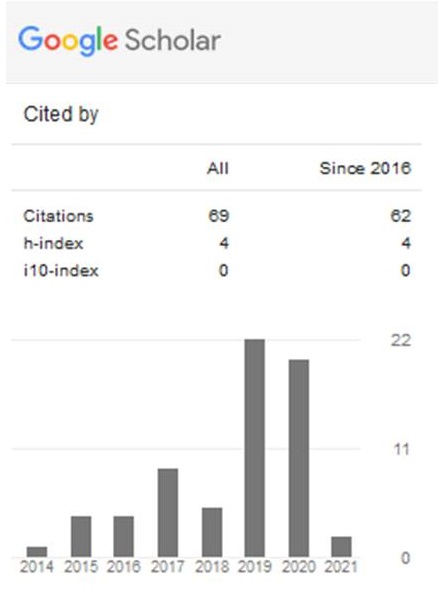Respons Beberapa Kultivar Kedelai (Glycine max L. Merril) terhadap Pemupukan Fosfor di Lahan Gambut
Abstract
This study was conducted to determine the potential of soybean cultivars and the proper dose of phosphorus fertilizer in peatlands. This study was conducted experiments with factorial experiment arranged using a randomized block design with three replications. The first factor is the cultivar comprising Kaba, Fan White, KM 14, KM 19 and KM-25. The second factor is the dose of phosphorus fertilizer consisting of 0 kg P2O5, 25 kg P2O5, 50 kg P2O5 and 75 kg P2O5 per ha. Each treatment was repeated 3 times in order to get 60 experimental unit. Parameters observed that biomass 28 days after planting, biomass 35 days after planting, leaf area of plants, leaf area index, the rate of growth in absolute, age flowering plants, harvesting age, the sheer number of pods pithy per plant, number of seeds per plant, seed weight per plant, grain weight per meter, 100-seed weight and harvest index. The data were analyzed using SAS version 9:12 satatistik program. Further analysis of the results was tested by LSD test. The final conclusion: 1). All varieties tested in the same potential for peat, although there was a tendency KM - 14 and KM – 19 better vegetative growth than other varieties. 2). In general fertilizer 25 kg P2O5 / ha respectively -masing better than the varieties that are not cultivated and fostered 50, and 75 kg P2O5 / ha, which indicate each variety of responses to P fertilization with a low dose.
Keywords
Full Text:
PDFReferences
Dudik, H. 2015. Lahan rawa solusi krisis kedelai. Balai Penelitian Pertanian Lahan Rawa (Balittra) Loktabat Utara, Banjarbaru, Indonesia.
Hanafiah, K. A: Dasar-dasar ilmu tanah. Cetakan I PT.Raja Grapindo Persada 2005. Jakarta.
Kesumasari, Nurita, dan K. Anwar. 2000. Pengaruh cara aplikasi dan takaran P pada tanaman
kedelai di lahan gambut. Makalah, disampaikan pada seminar hasil Penelitian Tanaman Pangan Lahan Rawa, 5-7 Juli 2000 di Banjarbaru.
Lakitan, B. 1996. Dasar- dasar fisiologi tanaman. Raja Grafindo Persada Jakarta. 203 hal.
Nuruzzaman,M. H. Lambers,M.DA. Bolland E.J Veneklaas. 2006. Distribution of carboxylates and acid phosphatase and depletion of different phosphorus fractions in the rhizosphere of a cereal, and there grain legumes. Plan soil 281:109-120.
Rasyad, A, dan Idwar. 2009. Interaksi genetik lingkungan dan stabilitas sifat agronomis galur kedelai hasil persilangan Kipas Putih dan Malabar. Laporan hasil penelitian (Tidak Dipublikasikan). Universitas Riau.
Shukla O.P, P.K. Singh, and P.B. Deshbhratar, 2010, Impact of Phosphorus on biochemical changes in hordeum vulgare L.In Mixed Cropping with Chickpea. Journal Of Environmental Biology. 31(5) : 575-580.
Soepardi, G. 1990. Siasat kecoh dalam pemupukan Fosfat. Kompas 18 Juni 1990.
Suhaya, Y. A. Rahman, Mardawilis dan Kardiyono. 2000. Penggunaan Rhizoplus sebagai alternatif penganti Urea dan mengurangi SP- 36 pada tanaman kedelai. Balai Penelitian Tanaman Pangan Padang Marpoyan. Riau.
Suprapto HS 2002; Bertanam kedelai. cetakan ke 21. Jakarta. Penebar swadaya.
Suryati, D. A. Munawar, Hasanudin, D.W. Ganefianti, dan D. Apriyanto, 1999. Perakitan varietas kedelai Glycine max (L) Merril) yang efisien menyerap hara P : Pewaris sifat efisiensi hara P (Penelitian Tahap III). Lembanga Penelitian UNIB. Bengkulu.
Sutedjo, M. M. 1994. Pupuk dan cara pemupukan. Rineka cipta. Jakarta.
Wang X. X. Yan, and H. Liao, 2010, Genetic improvement for Phosphorus efficiency in soybean : Radical Approach. Annuals of Botany 106 : 215-222.
Yuda, B, G. 2010. Komponen keragaman dan heritabilitas sifat kedelai yang ditanaman pada dua perbedaan suplay pupuk fosfor (P). Skripsi Fakultas Pertanian. Universitas Riau. Pekanbaru.
Refbacks
- There are currently no refbacks.

_2017.jpg)



